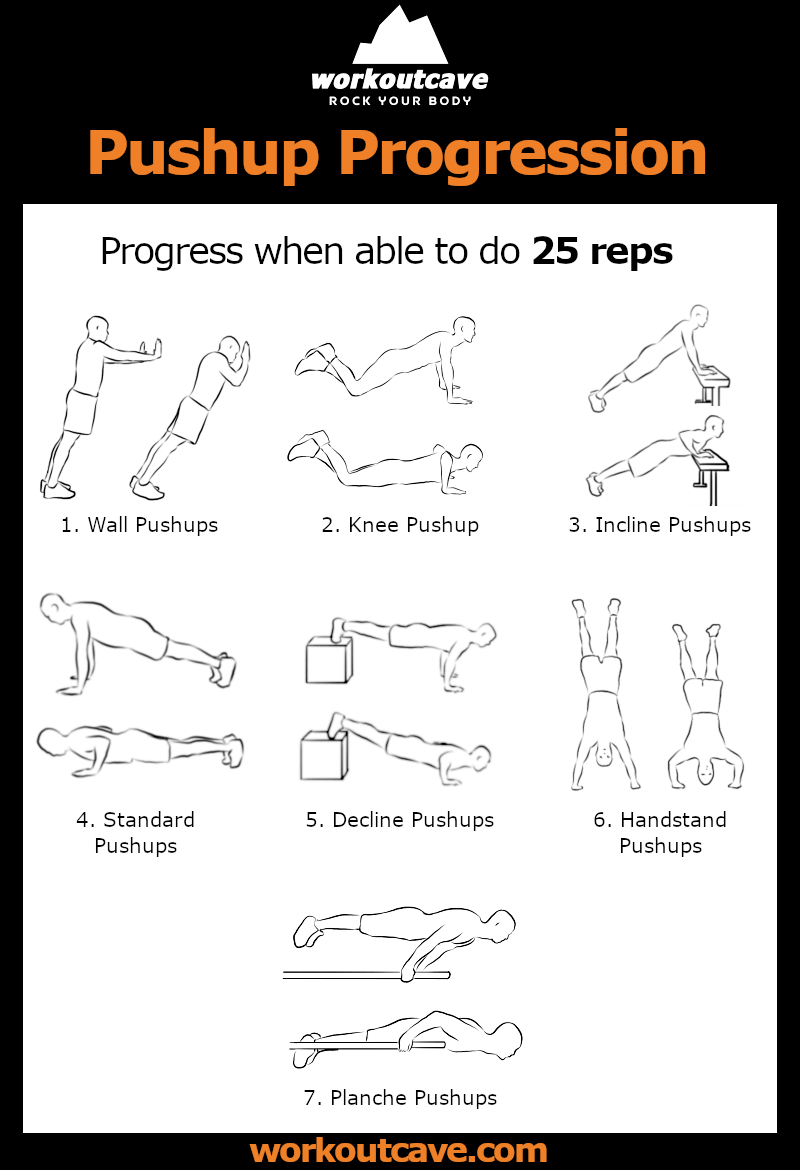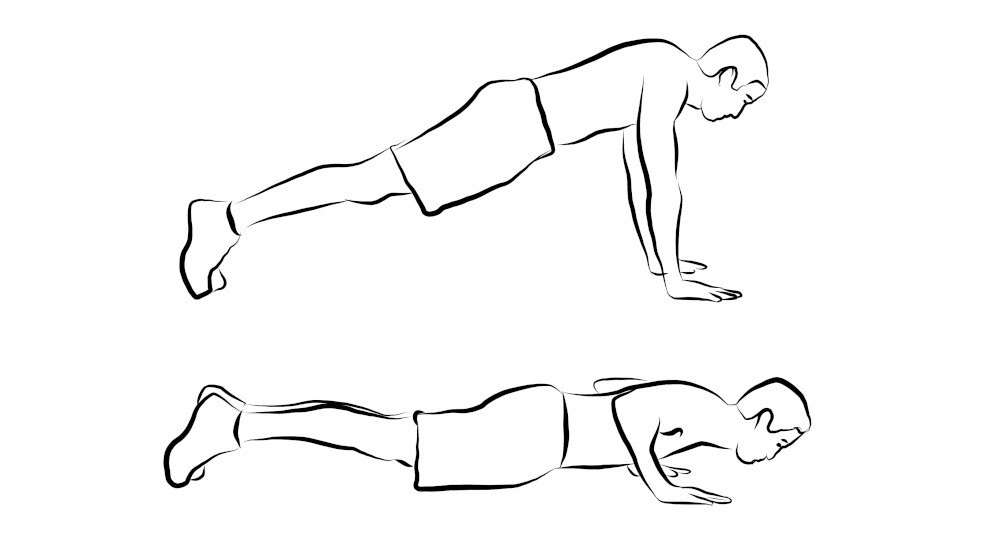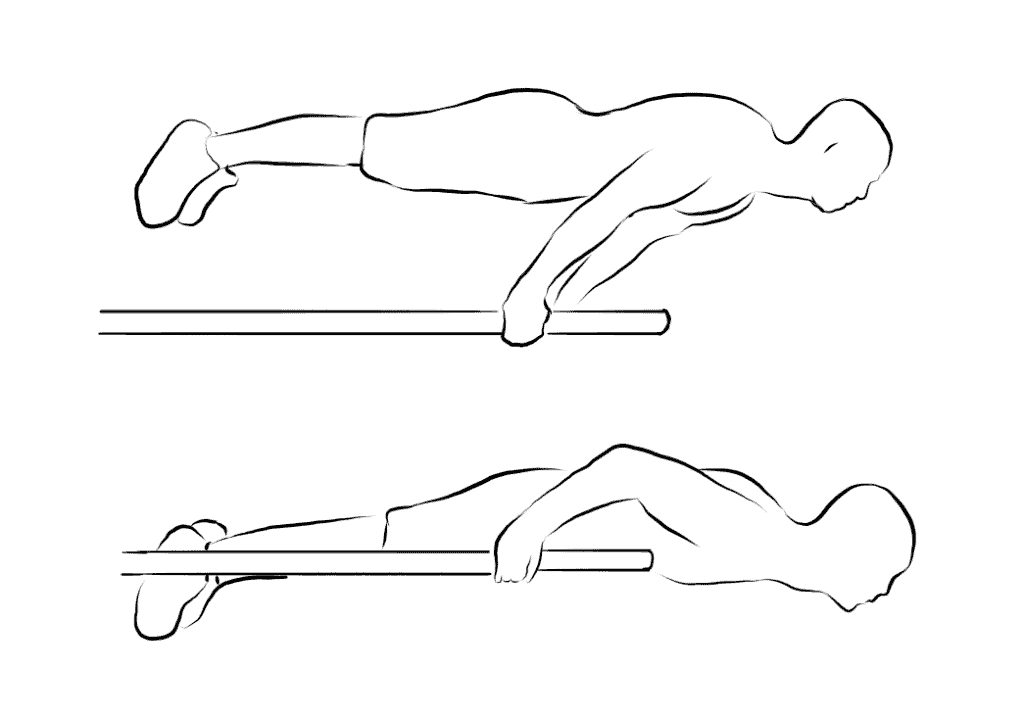Pushups may be the ultimate calisthenics exercise. Everybody and their grandparents have done Pushups at some point!
With such a popular movement you’d expect to see more variety and coaching to become better at the movement. But, that’s a rarity for general trainees.

Similarly to dips progression, this guide will show you all the regressions and progressions you’ll ever need with Pushups.
General Pushup Form
Pushups are one of the more basic exercises and it’s considered to be a paleolithic exercise. Simply push your body against gravity until your arms are fully extended.
But, some nuances can make a difference in training.
First, hand placement is crucial to proper muscle activation and shoulder health. Keeping the width slightly wider than shoulder-width is standard. Essentially, the inside of your hand should be in line with the outside of your shoulder.
Next, you need to ensure you keep a straight line from your head to your heels. That means your head can’t dip, your back can’t arch, your butt can’t flare up in the air, and your legs stay straight. This position needs to be maintained through each rep. Using your core, glutes, and quads is the best way to optimize your form.

Last, but not least, is the depth of a rep. In a perfect world, you can go down until your chest, nose, and hips are just grazing the ground before pushing back up. Chasing this depth may be a long process. Just ensure you don’t stop before you get within an inch or two from the ground with many body parts.
How To Move Through Progressions
To move through the progressions, you have to have a rep goal. For example, you want to be able to do sets of 25. With that goal, I wouldn’t move onto the next progression until you can do 25-30 reps of the current variation for all sets in a workout.
Here’s an example: you are currently working with Incline Pushups. You want to be able to do sets of 20. Your workout calls for 3 sets of 20-25 reps of Incline Pushups. You perform 25, 23, and 21 reps. This means you are ready to move on to Standard Pushups in your next home workout.
Use your rep goal throughout the progressions and move forward when you can!
As for where to initially start: it’s best to start with the variation that you know you can complete and move forward after the first workout.
If you have no idea, do a test with Knee Pushups:
- If you can’t do half of your rep goal, start with Wall Pushups.
- If you can hit your rep goal, but feel like you couldn’t do much more, stick with Knee Pushups.
- If you hit your rep goal and feel like you could do a few more, start with Incline Pushups.
- If you can double your rep goal, start with Standard Pushups.
Pushup Progression From Easy To Hard
Wall Pushups

Wall Pushups are done with your hands on a stable wall and your feet on the ground. The further your feet are from the walls the harder the movement becomes. Progress by stepping out further from the wall or move to the next variation.
Knee Pushups

Knee Pushups are just like a Standard Pushup, only with your knees on the ground instead of your feet. This reduces the resistance load on your upper body and allows for more reps. Move onto Incline Pushups next.
Incline Pushups

Incline Pushups are performed with your feet on the ground and your hands on a platform. The higher the platform, the easier the movement. Make progress by using a shorter platform or going directly to Standard Pushups.
Standard Pushups

The run-of-the-mill Pushup variation with your hands and feet on the floor. Move onto Paused or Pulsing reps next.
Pause/Pulse Pushups
Pause reps need a pause at the bottom of the movement, ensuring your body stays elevated. Pulse reps are performed with a small pulsing motion at the bottom of a rep. Once you get to the bottom, you slightly go back up, back down, and then back up for one rep.
You can progress by adding a longer pause, more pulses, or moving to the next variation.
Note – Paused and Pulsing reps can be used on any Pushup variation!
Decline Pushups

Perform these with your hands on the floor and your feet on an elevated platform. The higher the platform, the harder this move is. These can also be used to work on your Handstand Pushups.
Progress by using a higher platform or picking one of the next 3 harder variations to move to.
Weighted Pushups
Weighted Pushups are for those who want to maximize the training stimulus from Pushups for hypertrophy and strength. They don’t need skill and are a good choice for those not incorporating Dips or gymnastic based training.
You can work through all the Pushup variations from Incline to Decline with the same weight. You could also just increase the weight of your chosen variation. Ideally, you do both.
The easiest way to add weight is with a weight vest. An alternative is to use resistance bands, which will allow you to train the top of each rep harder, which is typically the easiest phase.
Handstand Pushups

Handstand Pushups are done with your feet up in the air or supported by a wall. This movement is a good choice for those who incorporate Dips in their training as their main chest training movement. This is because this movement shifts focus from the chest to the deltoids.
You can progress by adding weight or doing elevated reps with your hands on platforms to increase range of motion.
Planche Pushups

Planche Pushups are for those that want to add a bit of gymnastic training to their program, you will need two parallel bars like parallettes to perform this exercise. It’s not necessary for those just looking to maximize fitness. It’s simply a skill accrual.
Other Pushup Variations:
These variations aren’t typical Pushups but can have their place in training programs that need more specialized work.
- Diamond Pushups – performed with thumbs and index fingers touching to create a diamond shape. The focus shifts to the Triceps.
- One Arm Pushups – involves more Core activation and balance work.
- Crucifix Pushups – performed with your hands extra wide and your fingers pointed out. The range of motion is small, but the muscle activation is more isolated to the chest.
- Plyometric Pushups – great for those looking to build more power and explosion. Clap Pushups are a classic example.
- Uneven Pushups – performed with one hand on an elevated surface to create different mechanical stress on each arm. Good for imbalances.
Workout Summary

Cool down and Stretch
After each training it is beneficial to cool down. Our body is warmed up so it is in the great state to do follow up the workout with home stretch routine or light home cardio exercises. Studies find that cool down routine help athletes to recover quicker and lowers the chances of injuries.
Enough Reading – Ready To Train?
Now you know the intricacies of Pushups and how much they bring to the table for a proper Calisthenics program. They have a great role in bodyweight workouts and it is a fundamental exercise in every home workout!
Simply assess what variation you should start with and build up over time. The more advanced you get, the more variation you’ll be able to use!
Who says Pushups aren’t fun?!
